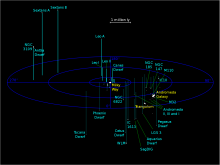Listen to today's episode of StarDate on the web the same day it airs in high-quality streaming audio without any extra ads or announcements. Choose a $8 one-month pass, or listen every day for a year for just $30.
You are here
Wavy Galaxies
If you can escape the glow of city lights, this is a great evening to watch the Milky Way. It forms a hazy band of light that stretches high across the sky. It arcs from Scorpius and Sagittarius in the south; through the Summer Triangle, high overhead; then down to W-shaped Cassiopeia, in the northeast.
That band of light is the glow of millions of stars in the disk of the Milky Way Galaxy.
If we could view the galaxy from afar, we’d see several bright, beautiful spiral arms wrapping through the disk. The arms aren’t permanent structures. Stars that are closer to the center of the galaxy take less time to complete an orbit than stars that are farther out. So if an arm was a permanent structure, it would either rip itself apart or wrap tighter and tighter around the galaxy’s core.
Instead, each arm may represent the crest of a wave. The wave circles around the galaxy like a wave of water on the ocean. In a galaxy, the wave squeezes giant clouds of gas and dust ahead of it. The clouds then give birth to new stars. Many of the stars are big, heavy, and bright, so they help outline the spiral arms. A wave also carries along lots of smaller stars, enhancing the spiral arm even more.
As the wave moves along, it compresses a new region of the galaxy. The stars in its wake spread out, and the brightest of them quickly expire. But new stars take their place — riding a wave through our beautiful galactic home.|
Script by Damond Benningfield






